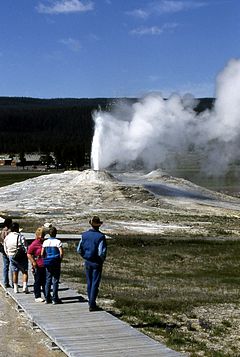Lion Geyser
In this article we will delve into Lion Geyser, a topic of great relevance today. Lion Geyser is a point of interest that has captured the attention of experts, academics and the general public due to its impact on various aspects of daily life. Through detailed analysis and exhaustive exploration of its different aspects, we seek to better understand the implications of Lion Geyser in today's world. Furthermore, we will examine its evolution over time and its influence in different fields, in order to offer a comprehensive vision that enriches the debate around this topic. Without a doubt, Lion Geyser is a topic that arouses great interest and controversy, so it is essential to address it with the seriousness and depth it deserves.
| Lion Geyser | |
|---|---|
 Eruption, 1987 | |
 | |
| Location | Upper Geyser Basin, Yellowstone National Park, Teton County, Wyoming |
| Coordinates | 44°27′50″N 110°49′51″W / 44.4640243°N 110.8309603°W |
| Elevation | 7,405 feet (2,257 m) |
| Type | Cone geyser |
| Eruption height | 90 feet (27 m) |
| Duration | 7 minutes |
| Temperature | 92.1 °C (197.8 °F) |
Lion Geyser is a cone-type geyser in the Upper Geyser Basin of Yellowstone National Park in the United States. It is located in the Geyser Hill complex.
It was named for the roaring sound of steam releasing during an eruption. Eruptions can reach 90 feet (27 m) and last from 1 to 7 minutes. Lion is the largest of the Lion Group which includes Little Cub Geyser and the currently inactive Big Cub and Lioness geysers.
Images of Lion Geyser
References
- ^ a b "Lion Geyser". Yellowstone Geothermal Features Database. Montana State University.
- ^ "Lion Geyser". Geographic Names Information System. United States Geological Survey, United States Department of the Interior.
- ^ "Geyser Hill". Geyser Observation and Study Association. Archived from the original on 2010-11-29. Retrieved 2010-11-11.
- ^ "Lion Geyser". Geyser Observation and Study Association.
- ^ "Lion Group of Geysers". National Park Service.


